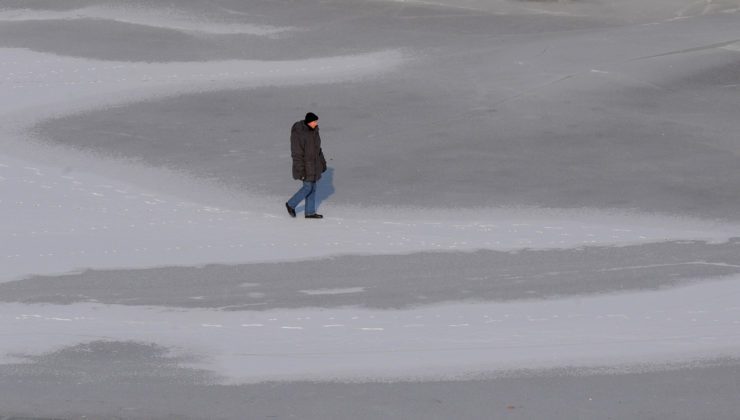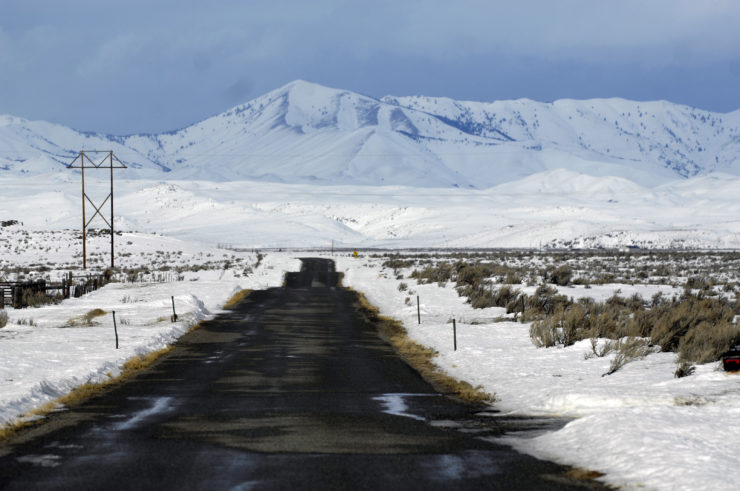Peter Stark’s second-person rendering of a hypothermic near-death experience took its 1997 print headline from the closing quatrain of an Emily Dickinson poem that, depending who you ask, is either an immortal bummer of a ballad to the totalizing anesthesia of grief or a Trojan Horse secreting the bittersweet notion that ceremonial rebirth follows the paralysis of loss.
This is the Hour of Lead –
Remembered, if outlived,
As Freezing persons, recollect the Snow –
First – Chill – then Stupor – then the letting go –
Within days of the story’s publication in Outside magazine, media outlets interviewing Stark were referring to the article by its less unwieldy dek, “The Cold Hard Facts of Freezing to Death,” a name that stuck for the next couple of decades. Then, in 2016, when Outside gave the piece a sexy new web treatment, the magazine abridged its hed even further, calling it simply “Frozen Alive.”
Like a digit amputated knuckle by knuckle, the damn title keeps getting shorter.
But the original is best, because there is something intimate and mournful about Stark’s description of the physiology of hypothermia, the slow bodily shutdown of a hapless “you” following a series of mishaps and mistakes. You’ve had a more or less harmless ditch encounter en route to a friend’s mountain cabin. You decide, hey, why not ski the last few miles? Then your binding breaks, putting you in a tough spot, and as you scour the moonlit snow for the missing piece, your situation begins to deteriorate.
You twist on your flashlight, and its cold-weakened batteries throw a yellowish circle in the snow. It’s right around here somewhere, you think, as you sift the snow through gloved fingers. Focused so intently on finding the bail, you hardly notice the frigid air pressing against your tired body and sweat-soaked clothes.
The exertion that warmed you on the way uphill now works against you: Your exercise-dilated capillaries carry the excess heat of your core to your skin, and your wet clothing dispels it rapidly into the night. The lack of insulating fat over your muscles allows the cold to creep that much closer to your warm blood.
Your temperature begins to plummet. Within 17 minutes it reaches the normal 98.6. Then it slips below.
Stark first cultivated an interest in the body’s response to extreme cold during an Outside assignment in Greenland in the early ’90s. He’d watched Inuit hunters there pursuing narwhals on the sea ice while wearing only light windbreakers and thin gloves. When he got back, he hatched a plan with Mark Bryant, Outside’s editor from 1990 to 1999, to pitch a tent on the coldest night of the year at Montana’s Rogers Pass — site of the lowest recorded temperature in the Lower 48 — and chronicle the campout’s effects on his body.
You’ve had a more or less harmless ditch encounter en route to a friend’s mountain cabin. You decide, hey, why not ski the last few miles?
But on the appointed day, met by 50 mile-per-hour winds and negative-50-degree temps, Stark decided the effort was foolhardy. He floated camping in his backyard instead, but a skeptical Bryant countered with Plan C: Why not send a fictional character into the frigid Montana night, a sort of everyman who could suffer in Stark’s place?
Thus what might have been a macho adventure-stunt testimonial became a piece of supremely approachable science writing, prefiguring everything from Mary Roach’s never-ending string of bestsellers to pseudo-educational reality-TV survival schlock. The great strength of “As Freezing Persons” is its unexpected relatability. Bryant suggested the second-person POV, which Stark had used effectively in some short, expository Outside pieces. And Stark proposed ripping off Jack London’s “To Build a Fire,” which has as its protagonist not some intrepid polar explorer but a regular schmo out to visit friends.
“The magazine was beginning to bring in a lot more readers,” Bryant recalls. Recent Outside stories would birth two of that year’s bestselling books, Jon Krakauer’s “Into Thin Air” and Sebastian Junger’s “The Perfect Storm.” “I think one of the things we were interested in then was elevating storytelling, but also shifting the sensibility a bit — less of the hairy-chested, man-against-nature thing, less about superpeople and more about ordinary people in extraordinary circumstances.”

“We look back at it now as our golden age — it was like the culture had caught up with what Outside had been talking about for years,” remembers Laura Hohnhold, then a senior editor at the magazine. “The key to the success of Peter’s story is not only the second person, but the mundane circumstance that sets the disaster in motion. You’re able to empathize with this. Readers were used to reading about people dying in horrible ways — freezing to death and all that — but having it happen on K2 is very different than having it happen on a back road near your house.”
That second-person voice — omniscient, narratorial — also makes for smooth pivots from storytelling to exposition and back. The narrative action on the mountainside becomes the vehicle for a degree-by-degree catalog of a diminishing core temperature’s effects on the circulatory and nervous systems. To compile it, Stark leaned heavily on Paul Auerbach’s “Wilderness Medicine” — a backcountry bible found on every guide’s shelf — along with a stack of medical journals and interviews with doctors and an acquaintance once stranded overnight on the back side of a Montana ski hill.
Apathy at 91 degrees. Stupor at 90.
You’ve now crossed the boundary into profound hypothermia. By the time your core temperature has fallen to 88 degrees, your body has abandoned the urge to warm itself by shivering. Your blood is thickening like cranckcase oil in a cold engine. Your oxygen consumption, a measure of your metabolic rate, has fallen by more than a quarter. Your kidneys, however, work overtime to process the fluid overload that occurred when the blood vessels in your extremities constricted and squeezed fluids toward your center. You feel a powerful urge to urinate, the only thing you feel at all.
The most ambitious pivot comes just over halfway through the 4,000-word piece, when the nameless protagonist loses consciousness and the POV shifts to third person as rescuers and doctors begin a fraught attempt at revival. The story dwells here for 1,100 words, its former subject now a nearly lifeless object, and it’s hard not to feel empathy for the stiff on the table who just moments ago was you.
“To have kept up the second person there would have been hard,” says Hohnhold, who edited the piece and remembers discussing the transition with Stark. “It would have been too forced: ‘You’re unaware of this now, but the doctors are flushing your body with saline.’”
Instead, the attempted resuscitation reads like an out-of-body experience, mildly surreal, revealing as much or more about the physiology of hypothermia as the act of freezing; the piece would have been a shallower scientific dive had its subject simply died up there on the mountain.
The doctor shakes his head. He can’t remember seeing numbers so low. He’s not quite sure how to revive this man without killing him.
In fact, many hypothermia victims die each year in the process of being rescued. In “rewarming shock,” the constricted capillaries reopen almost all at once, causing a sudden drop in blood pressure. The slightest movement can send a victim’s heart muscle into wild spasms of ventricular fibrillation. In 1980, 16 shipwrecked Danish fishermen were hauled to safety after an hour and a half in the frigid North Sea. They then walked across the deck of the rescue ship, stepped below for a hot drink, and dropped dead, all 16 of them.
“78.9,” a technician calls out. “That’s three-tenths down.”
Stark weaves in the medical details with staccato precision. He doesn’t linger, pour on adjectives or flirt with the garish, and the effect is a lesson in physiology that’s haunting but never macabre.
“The key to the success of Peter’s story is not only the second person, but the mundane circumstance that sets the disaster in motion. You’re able to empathize with this. Readers were used to reading about people dying in horrible ways — freezing to death and all that — but having it happen on K2 is very different than having it happen on a back road near your house.”
“The writing is very similar to how you would write for the ear,” says Peter Frick-Wright, co-producer and host of Outside’s Science of Survival podcast, which explores a life-or-death scenario — killer bees to lightning strikes — in each episode. “The cold is just this blunt force of nature that’s not going to beat around the bush with its diction or syntax, and I think Stark was kind of channeling that. Every sentence gives some big new piece of information. And it happens to be the perfect voice for getting someone’s attention and keeping it.”
It’s why Frick-Wright and producing partner Robbie Carver adapted “As Freezing Persons” for the debut episode of Science of Survival in 2016, abridging the story and augmenting it with what Frick-Wright calls “the sounds of suffering”: labored breathing, hallucinatory bells and voices, strains of Foreigner’s “Cold as Ice.” The podcast, a co-production of Outside and the Public Radio Exchange, brought Stark’s story to a new medium — if not a new audience, as digital general manager Scott Rosenfield includes the piece in a suite of Outside classics that have reliably generated traffic for years. Two decades after its publication, it remains eminently shareable, Rosenfield says, enjoying regular love from aggregator sites like Digg and Longreads. As recently as last month, it was the fourth-most read story on Outside’s site, following a shout-out from Longform.org.
Stark himself anticipated Science of Survival’s catastrophe-du-jour approach in his 2001 book, “Last Breath: The Limits of Adventure.” Each chapter brings the same hypothetical-character approach (though not the second-person POV) to a new manner of dying in the out-of-doors: drowning, dehydration, malaria, avalanche. (Also heatstroke, in an essay almost too contrapuntal to the one that inspired it.) Many of “Last Breath’s” invented characters meet gruesome ends, and Stark explains in the book’s introduction how he hoped the high body count would help readers reflect with clarity on their own mortality, cutting through the fear and denial with which Western culture tends to enshroud death.
“For some,” he said, “it became a way to understand what it might feel like to die, this universal experience. We all die.”
You do not die — that is, the you of “As Freezing Persons” — which brings us back to Emily Dickinson and to the story’s exquisite elegiac character. In the final 600 words, Stark executes one last pivot, the story’s most affecting. You wake up, immobile and amnesiac, as the POV returns to second person. After hearing the doctors discuss the fate of your fingers — they may yet escape amputation — you gaze at the mess of tubes linking you to a bag of warm saline, liquid heat being restored to you, and the story’s final paragraphs narrate an epiphany.
And with a lurch that would be a sob if you could make a sound, you begin to understand: The bag contains all that you had so nearly lost. These people huddled around you have brought you sunlight and warmth, things you once so cavalierly dismissed as constant, available, yours, summoned by the simple twisting of a knob or tossing on of a layer.
But in the hours since you last believed that, you’ve traveled to a place where there is no sun. You’ve seen that in the infinite reaches of the universe, heat is as glorious and ephemeral as the light of the stars. Heat exists only where matter exists, where particles can vibrate and jump. In the infinite winter of space, heat is tiny; it is the cold that is huge.



